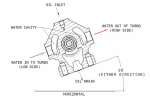What do you think cools the oil?
Think about what you wrote there.......
The stock 3116 doesn't have water cooled turbo, so the oil still gets cooled by the exact same method.
All the data out there points to water cooling primarily working after engine shut down when the turbo experiences heat sink. Proper plumbing allows the cooling to dissipate that heat into the coolant.
Since the engine isn't running it certainly won't overheat.
Meanwhile the turbo bearings aren't coking up with overheated oil.
YMMV, but I'll stick to going this route, and since nobody posting here appears to have actually done so, I'll be sure to share the results.






